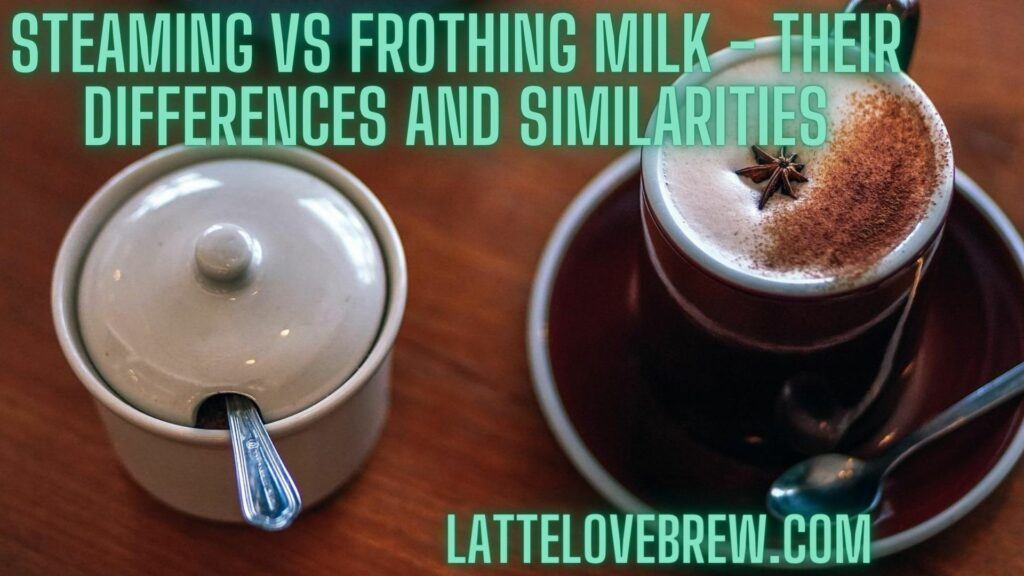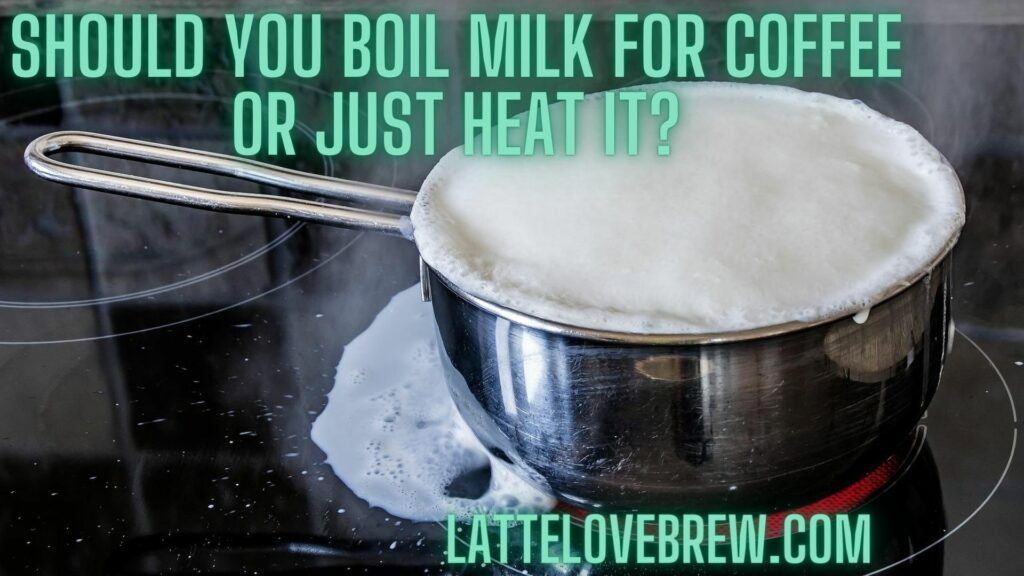Last updated on May 20th, 2024 at 12:03
For those that have stepped up their coffee skills and invested in a home espresso machine a question I often get PM’d is “Can I use regular coffee for espresso machine?”
This article is dedicated to the whole topic of coffee for espresso machines. Which coffee? What roast? What grind size? Are all questions that are answered in this article, and a lot more!
Keep reading as we dive into this topic!
What Is An Espresso?
Table Of Contents
- 1 What Is An Espresso?
- 2 Do You Need An Espresso Machine To Make An Espresso?
- 3 What Kind Of Coffee Do You Use To Make An Espresso?
- 4 Which Roast Is Best For an Espresso?
- 5 Best Coffees For Espresso Machine?
- 6 Frequently Asked Questions About Coffee For Espresso Machine
- 6.1 What Coffee Grind Is Best For Espresso?
- 6.2 Can You Use Pre Ground Coffee In An Espresso Machine?
- 6.3 How Fine Should I Grind My Coffee For Espresso?
- 6.4 What Coffee Does Starbucks Use For Espresso?
- 6.5 What Kind Of Coffee Do You Use In Espresso Machine?
- 6.6 Do You Just Use Regular Coffee For An Espresso Machine?
- 6.7 What Roast Is Best For Espresso?
- 6.8 Can I Use Instant Coffee In Espresso Machine?
- 7 Frappé-Ing It All Up – Coffee For Espresso Machine?
An espresso is a strong, concentrated and focused shot of black coffee with a beautiful crema on top, which is often a light caramel-colored crema.
A shot of espresso forms the base for many milk based coffee drinks, such as a latte, a mocha, a cortado, flat white, a cappuccino and a macchiato, for example, which is why it is one of the most important coffee drinks that you can learn to make.
A shot of espresso is higher in caffeine on a per volume (per ounce or per ml) basis. It’s thicker and stronger in taste when enjoyed straight or better still as a double shot as it is a small, typically 1 ounce (30 ml) only.
On the subject of caffeine, a single shot of espresso usually, and rather surprisingly, has less caffeine per serving due to the rather small serving. Approximately 65 mg of caffeine per ounce (30 ml) meaning it would take a triple espresso shot to match the amount of caffeine in a French press coffee.
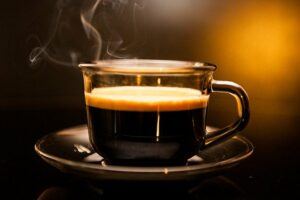
Read: Good espresso beans
Do You Need An Espresso Machine To Make An Espresso?
While some might argue that you don’t need an espresso machine to make an espresso and perhaps point you towards a capsule espresso machine like an espresso or a Keurig or even an Aeropress.
Others may insist that you can make a reasonable espresso with a Moka pot.
I have nothing against capsule machines, nor an Aeropress or a Moka pot, I in fact own a capsule machine, an aeropress and a Moka pot.
A moka pot can get you that strong, focused espresso to use as a base for the milk based drinks and the same can be said for an Aeropress.
A Nespresso, on the other hand, walks like a duck, quacks like a duck but is not a duck! The espresso made by them closely resembles an espresso but is not quite an espresso. You’ll notice it when you drink one.
Perhaps an inexperienced espresso drinker or a casual espresso drinker won’t notice much of a difference.
To truly make a great espresso with great quality thick and rich creamy crema on top is to use fresh oily beans and a home espresso machine. There is literally no other way for you to get the 9 bar of pressure required to produce the creamy crema on top.
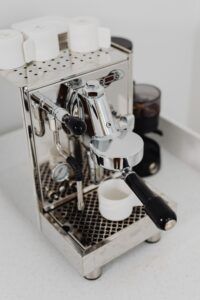
What Kind Of Coffee Do You Use To Make An Espresso?
The next step in making a great espresso at home is selecting the right coffee beans and the right roast; after all, Starbucks offers espresso in a blonde roast as well as a dark roast and has medium roasts also.
The question is which roast will get you the best espresso shot and for which coffee drink, and can you use any roast in your espresso machine?
Which Roast Is Best For an Espresso?
Which roast is best for making an espresso is best determined by what type of coffee it is you are making with your espresso machine or if the espresso shot you are making forms the base of another coffee drink and what you want to achieve with that espresso shot.
If you want some great aromas and flavors of origin in your latte or macchiato, then a good medium roast will be what you are looking for.
If you want to brew a caramel latte with a good, strong coffee taste too, then it is a dark roast that will serve your needs more as this roast will cut through the milk better than a medium roast.
For an espresso shot it will depend on the quality and density of the crema that you want and the taste profile.
If you want to enjoy your espresso with a flavor of the coffee bean origin, then a medium roast is what you are looking for. If you want bold espresso with a real good thick creamy crema on top, a dark roast will get you the result that you are seeking.
Best Coffees For Espresso Machine?
Now that we have covered the roast level and what type of coffee you want to make and what your goal is for the types of coffee you want to make, it is time to discuss the actual coffee as this, too, is going to have a large influential factor on how your cup of coffee or espresso is going to end up.
Colombian Coffee
Colombian coffee is sharp, sweet, low in acidity and has chocolaty and nutty tones and will produce just a little crema on your shots of espresso.
For an espresso, Colombian coffee will give you a “more ligero”, a lighter taste. It’s a great option and best enjoyed as a medium roast and seeking out either a 100% Colombian coffee by itself or a 100% location specific Single origin Colombian coffee.
If you are looking for a single origin Colombian aim for one of their many volcanic coffees.

Indonesian Coffee
The most famed coffee from this trans-continental and trans-hemisphere nation is from an Island I love, Sumatra and Sumatran coffee is excellent for making espresso due to the intense flavor and low acidity with earthy tones from their volcanic coffee.
Sumatran coffee is not at all bitter and makes a good, strong, bitter free coffee.
Ethiopian Coffee
If you want a truly delicious arabica coffee and a great espresso or latte, give good consideration to Ethiopian Yirgacheffe coffee, you’ll get reasonably good creama on top with all medium roasts and especially the dark roast with an amazing floral tones with the medium roast dancing on your taste buds with every sip you take.
As an espresso, dark roast you’ll experience a nice bite to your shot. Ethiopian coffee is rather delightful and is the birthplace of coffee.
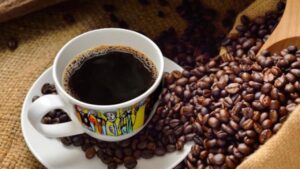
Kona Coffee
Kona coffee is amongst the most expensive in the world and is well worth it! You will enjoy great volcanic coffee from Hawaii’s big Island. Pay attention to what you are buying as a “Kona Blend”, unfortunately, has very little Kona beans.
Legally speaking, only 10% of beans in a Kona blend are required for the product to qualify as a kona blend.
Undoubtedly, it is far better to get a single origin 100% Kona coffee to enjoy the flavor of this unique American coffee.
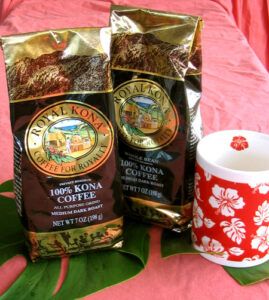
Blends
While I have advised that you look for 100% Kona and 100% Colombian coffee, the reason being these are two very good, stand-out specialty coffees and worth enjoying as they are and not as a blend.
I have nothing at all against a blend. Most espresso roasts that you see are indeed a blend. Often they are a blend of Arabica and Robusta beans with 75% to 80% of the beans being Arabica with 20% to 25% being Robusta.
The reason robusta beans are added to an espresso roast is to boost the caffeine content. Blends do make great coffee. If you are in the habit of buying different coffee, you can experiment with your own blend by mixing the beans that you have around your kitchen and end up with a blend, a real good mix of flavors.
A fine example of the coffees listed above is mixing your Ethiopian coffee with Colombian coffee and a touch of Kona coffee in equal parts. You will enjoy the balance of the floral flavors of the Ethiopian beans, the light and reduced acidity and smoothness of the Colombian beans and the profound flavors of your Kona beans.
Sometimes I have been known to throw in some very dark Italian roasted beans, the highest roast profile, to ensure a good quality crema on my espresso.
If you are mixing beans and making your own blend. Be sure to put them in a cup, shake them and then put them in your grinder. The goal of doing so is to ensure they are evenly mixed when you are grinding them.
I tend to go a little step further and shake the grinds in a cup to ensure an even mix of the coffee grinds.
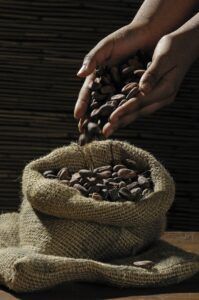
Frequently Asked Questions About Coffee For Espresso Machine
What Coffee Grind Is Best For Espresso?
For a good quality espresso, you will ideally use the smallest grinding setting on your grinder. The goal is a small powder-like grind that has a particle size of 1/32 of an inch or 80 to 100 microns. On most grinders, the smallest setting will get you a grind size that small.
Can You Use Pre Ground Coffee In An Espresso Machine?
Yes,
preground coffee beans are okay to use on your espresso machine or any coffee machine for that matter, be it a drip coffee maker, a chemex, a siphon or whatever it may be.
Keep in mind that to make a good espresso it is a small powder like grind that you need, which may not be available as pre ground or may require you to request that particular size.
The grind size will affect how your coffee tastes and your brew time.
How Fine Should I Grind My Coffee For Espresso?
You should grind your coffee beans to a very fine grind that resembles a powder. 80 to 100 micros is small enough. Smaller, 50 microns and you are bordering on the super fine flour-like grind size of Turkish coffee which requires a specialist grinder.
What Coffee Does Starbucks Use For Espresso?
Starbucks uses their own signature dark espresso roast for most of their espresso based drinks. The roast, surprisingly, was first created and blended way back in 1975 and has remained unchanged since then.
Starbucks also has a blonde espresso which is higher in caffeine and is creamier in taste.
What Kind Of Coffee Do You Use In Espresso Machine?
Strictly speaking, you can use all kinds of coffee in your espresso machine, but you will not get great results from light roasts or medium roasted coffee beans. Darker roasts like a good dark roast of a French roast or an Italian roast are best. At a squeeze, a medium-dark roast will get you quality coffee.
The reason that dark roasts work much better and get you that delicious shot is down to the beans being more oily. You need the oil to get that thick, rich crema on top. Freshly roasted coffee works the best due to having a greater presence of coffee oils on the surface of the coffee beans and coffee grounds.
You must use a fine, very fine powder like grind size.
Do You Just Use Regular Coffee For An Espresso Machine?
Yes, you can use regular coffee in your espresso machine. It does not have to be expensive coffee like specialty coffee. Pre ground coffee must be ground to an espresso grind as too large a grind size will result in a watery coffee due to a poor contact time between the hot water and the coffee grounds.
What Roast Is Best For Espresso?
This is open to opinion; some coffee lovers and coffee enthusiasts will insist that a medium dark roast is best as you’ll get at least some flavor of the origin from the beans. The slight problem with medium dark roasts for an espresso shot is their lack of coffee oil on the surface, resulting in a lower quality crema and shots of coffee that have a notably thinner crema.
This is what makes an espresso roast, also known as an espresso roast, and an italian roast better.
Can I Use Instant Coffee In Espresso Machine?
No, instant coffee is soluble. The coffee extraction process will have been skipped over as the coffee dissolves into the hot water. You’ll end up with a very disappointing and watery cup of coffee.
Frappé-Ing It All Up – Coffee For Espresso Machine?
If you have read this far, you know which type of coffee will work well for espresso machines and making espresso shots. You also know what roast type to use, when and why.
All that is left for you to do is to sit down and think about what beans you want to buy and for what kind of coffee you want to make.
What coffee for espresso machine do you use? What is your favorite? Join our cool coffee community and let us know. Feel free to suggest some great beans to us. Find us on Facebook/Meta.


